Guide E-316
Revised by Nancy Flores and Cindy Schlenker Davies
College of Agricultural, Consumer and Environmental Sciences, New Mexico State University
Authors: Respectively, Extension Food Technology Specialist, Department of Extension Family and Consumer Sciences; and County Program Director/Extension Home Economist, Bernalillo County Extension Office, New Mexico State University. (Print Friendly PDF)
NOTE: This publication is intended for use by individuals with a basic understanding of canning procedures. For more detailed information, consult the USDA Complete Guide to Home Canning, which is available at https://nchfp.uga.edu/publications/publications_usda.html.
Tasty fruit fillings for pies, pastries, and dessert toppings can be prepared at home. The following pie fillings are excellent, safe products when processed according to the directions in each recipe. Each canned quart makes one 8- to 9-inch pie.
Many factors affect a fruit’s flavor, so you may wish to adjust the sugar and spices in each recipe to suit your tastes. This is best done by preparing a single quart of filling, making a pie, and tasting it. However, never decrease the amount of lemon juice in the recipe because it ensures the filling’s safety and storage stability.
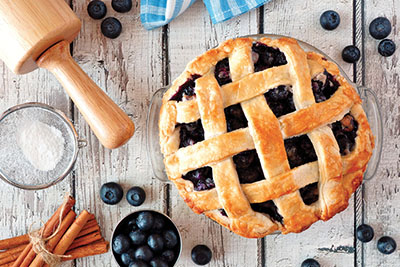
© Jenifoto406 | Dreamstime.com
General Canning Procedures
Use regular or wide-mouth Mason jars with self-sealing lids held in place by screw-on metal bands. The bands hold the lids in place during the processing and cooling periods. Mason jars are made of tempered glass to resist high temperatures. Jars are available in 1/2-pint, pint, 1 1/2-pint, and quart sizes. Larger jars are not recommended for home canning.
Inspect jars carefully for cracks or chips and discard faulty ones. Wash jars in hot, soapy water and rinse thoroughly, or wash in the dishwasher. When canning, keep jars hot by storing them in the dishwasher, a sink of hot water, or in a warm oven until they are filled. Check metal screw bands for signs of rust or dents and discard badly corroded or dented bands. Use only new self-sealing lids and follow manufacturer’s directions for preparing lids for canning. Ladle fruit mixture into jars, leaving a 1-inch headspace, or as indicated. Wipe the sealing surface of jars with a clean, damp paper towel. Add lids, tighten screw bands, and process in a boiling-water canner.
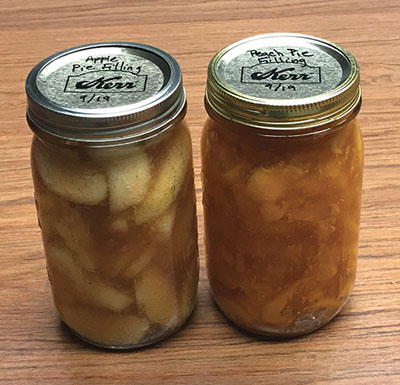
Follow these steps for successful boiling-water canning:
-
Fill the canner halfway with water.
-
Preheat water to 140°F for raw-packed foods, or 180°F for hot-packed foods.
-
Load filled jars, fitted with lids and bands, into the canner rack and use the handles to lower the rack into the water; or fill the canner, one jar at a time, using a jar lifter.
-
Add enough water so the water level is at least 1 inch above jar tops. For processing times over 30 minutes, the water level should be at least 2 inches above the tops of the jars.
-
Turn heat to its highest position, put the lid on the canner, and heat until water boils vigorously.
-
Set a timer for the minutes required for processing the food (Table 1).
-
Keep the canner covered and lower the heat setting to maintain a gentle boil throughout the process schedule.
-
During processing, add more boiling water so the water level is at least 1 inch above jar tops. For processing times over 30 minutes, the water level should be at least 2 inches above the tops of the jars.
-
When jars have been boiled for the required time, turn off the heat and remove the canner lid. Wait 5 minutes before removing jars.
-
Using a jar lifter, remove the jars and place them on a towel, leaving at least 1-inch spaces between the jars during cooling. Let jars sit undisturbed at room temperature for 12 to 24 hours to cool.
Test for Jar Seals
Remove screw bands when jars have cooled (12 to 24 hours) and test for vacuum seals by these methods:
- Press the lid center with your finger. If the lid springs up when released, it is not sealed.
- Tap the lid with a small metal spoon. A sealed jar lid will make a ringing sound.
- Hold the jar at eye level and look across the lid. A sealed jar lid curves down slightly in the center.
If liquid has been lost from sealed jars, do not open the jars to replace the liquid; instead, store them in the refrigerator and use these first.
Reprocessing Unsealed Jars
If you decide to reprocess foods from jars that did not seal, do so within 24 hours. Remove and discard lids from unsealed jars. Check the sealing surface of the jar for tiny nicks or cracks. If the jar has defects, discard it and replace it with another jar. If not, add a new lid and process for the original processing time. Label food that has been re-canned, store in the refrigerator, and use within several days. The produce will be softer in texture and lower in nutritional value than food processed once.
Storing Canned Food
If lids are tightly vacuum-sealed, remove the screw bands from sealed jars to prevent them from rusting closed on the jars. Wash, dry, and store the screw bands for later use. Clean the outsides of sealed, cooled jars. Label with date and contents and store in a cool (50–70°F), dark, dry place away from sun, light, or dampness. Canned products are best if eaten within one year.
Accidental Freezing
Freezing may cause food in jars to spoil if the jars become unsealed. Freezing and thawing cause food to soften and decrease its nutritional quality. Protect jars from freezing by wrapping with layers of newspaper.
If Canned Food Spoils
Examine jars carefully before tasting contents. Check lids for a vacuum seal. NEVER taste food from an unsealed jar.
Signs of food spoilage are streaks and dried food at the top of the jar, swollen lids, broken jar seals, rising air bubbles, and any unnatural color. Other indicators include bad or unnatural odor, spurting liquid, foaming, or white, blue, green, or black mold.
Dispose of any food you suspect of being spoiled. For safety, spoiled canned food and containers may need to be detoxified before disposal. Contact your county Extension office for detoxification instructions.
Elevation Adjustments
All communities in New Mexico are above sea level, varying from 3,000 to 10,000 feet, with elevation differences even within a county. The boiling temperature of liquids is lower at higher elevations, and therefore food must be processed longer at high elevations (Table 1). Use Table 2 to determine the elevation of your community, and then select safe processing times from Table 1 for canning your fruit. Special Notice About Clear Jel
|
Table 1. Recommended Processing Times for Fruit Pie Fillings in a Boiling-Water Canner |
||||
|
Process times at elevations of |
||||
|
Fruit filling |
Jar size |
up to 3,000 ft |
3,001–6,000 ft |
6,001–9,000 ft |
|
Apple |
Pints or quarts |
30 min |
35 min |
40 min |
|
Blueberry |
35 min |
40 min |
45 min |
|
|
Cherry |
35 min |
40 min |
45 min |
|
|
Peach |
35 min |
40 min |
45 min |
|
|
Table 2. Elevations of Cities and Towns in New Mexico |
|||
|
City/Town |
Elevation (ft) |
City/Town |
Elevation (ft) |
|
Alamogordo |
4,350 |
Las Vegas |
6,450 |
|
Albuquerque |
5,000 |
Logan |
3,830 |
|
Artesia |
3,350 |
Lordsburg |
4,250 |
|
Aztec |
5,650 |
Los Alamos |
7,400 |
|
Bayard |
5,800 |
Los Ranchos de Alb. |
4,950 |
|
Belen |
4,800 |
Lovington |
3,900 |
|
Bernalillo |
5,050 |
Magdalena |
6,555 |
|
Bosque Farms |
4,865 |
Melrose |
4,600 |
|
Carlsbad |
3,100 |
Mora |
7,200 |
|
Carrizozo |
5,450 |
Mosquero |
5,550 |
|
Chama |
7,900 |
Mountainair |
6,500 |
|
Cimarron |
6,450 |
Portales |
4,010 |
|
Clayton |
5,050 |
Raton |
6,650 |
|
Cloudcroft |
8,650 |
Reserve |
5,750 |
|
Clovis |
4,300 |
Rio Rancho |
5,290 |
|
Columbus |
4,020 |
Roswell |
3,600 |
|
Corona |
6,665 |
Roy |
5,900 |
|
Corrales |
5,005 |
Ruidoso |
7,000 |
|
Cuba |
7,000 |
San Jon |
4,200 |
|
Deming |
4,300 |
Santa Fe |
7,000 |
|
Dexter |
3,500 |
Santa Rita |
6,300 |
|
Eagle Nest |
8,250 |
Santa Rosa |
4,600 |
|
Elida |
4,345 |
Silver City |
5,900 |
|
Española |
5,600 |
Socorro |
4,600 |
|
Estancia |
6,100 |
Springer |
5,800 |
|
Farmington |
5,400 |
Taos |
7,000 |
|
Fort Sumner |
4,050 |
Texico |
4,150 |
|
Gallup |
6,500 |
Tierra Amarilla |
7,460 |
|
Grants |
6,450 |
T or C |
4,250 |
|
Hobbs |
3,650 |
Tucumcari |
4,100 |
|
Hurley |
5,700 |
Tularosa |
4,500 |
|
Jemez Springs |
6,200 |
Vaughn |
5,950 |
|
Las Cruces |
3,900 |
Wagon Mound |
6,200 |
Special Notice About Clear Jel
The following recipes all use a modified food starch called Clear Jel, which is recommended by the USDA for home canned fruit pie fillings. This starch produces the correct thickening, even after fillings are canned and baked. Other starches, such as cornstarch, break down and result in a runny filling. Clear Jel must be used as the thickener in these recipes; there is no appropriate substitute.
Clear Jel may not be available in all grocery stores, but it is easy to find online. Obtain your Clear Jel before preparing these pie fillings. One pound of Clear Jel yields about 3 cups. The following fruit pie filling recipes use about 1 1/2 to 2 1/4 cups per 6 to 7 quarts of pie filling.
Before adding Clear Jel and sugar to liquid (juice and water), make a slurry with small amount of the liquid. This will prevent “clumping.” An immersion blender can be used to make a slurry that will not have clumps and will be easier to incorporate with the other ingredients.
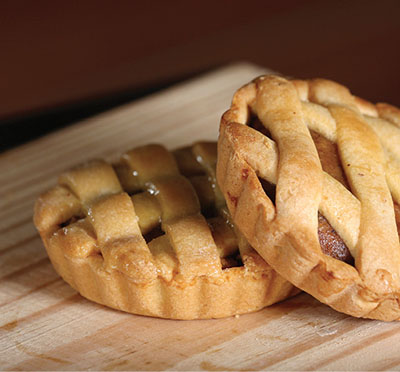
© Nishant Aneja | Pexels.com
|
Apple Pie Filling |
||
|
Quantities of ingredients needed for |
||
|
Ingredients |
1 quart jar |
7 quart jars |
|
Fresh sliced apples |
3 1/2 cups |
6 quarts (24 cups) |
|
Granulated sugar |
3/4 cup plus |
5 1/2 cups |
|
Clear Jel |
1/4 cup |
1 1/2 cups |
|
Cinnamon |
1/2 teaspoon |
1 tablespoon |
|
Bottled lemon juice |
2 tablespoons |
3/4 cup |
|
Cold water |
1/2 cup |
2 1/2 cups |
|
Apple juice |
3/4 cup |
5 cups |
|
Yellow food coloring (optional) |
1 drop |
7 drops |
|
Nutmeg (optional) |
1/8 teaspoon |
1 teaspoon |
Quality. Use firm, crisp apples. Stayman, Golden Delicious, Rome, and other varieties of similar quality are suitable. If apples lack tartness, add an additional 1/4 cup of lemon juice for each 6 quarts of slices.
Procedure. Wash, peel, and core apples. Cut into slices 1/2 inch wide. Prevent browning by placing slices in one gallon of water mixed with 1 teaspoon of ascorbic acid crystals or six 500-mg vitamin C tablets. Place 6 cups of apples at a time in 1 gallon of boiling water and cook for 1 minute after the water returns to a boil; drain well. Keep heated apples in a covered pot or bowl to retain heat while other batches of apples are being blanched.
In a large pot, combine cold water and apple juice, then stir in sugar, Clear Jel, and cinnamon. If desired, add food coloring and/or nutmeg. Stir and cook on medium-high heat until mixture thickens and begins to bubble. Add lemon juice and boil 1 minute, stirring constantly. Fold in drained apple slices. Fill hot jars with mixture, leaving a 1 1/2-inch headspace. Remove air bubbles and adjust headspace if needed. Process immediately.
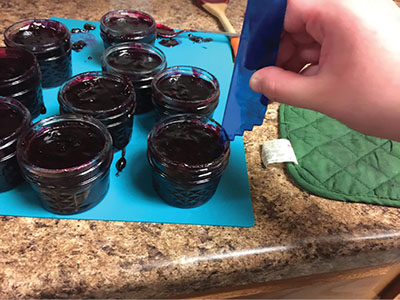
|
Blueberry Pie Filling |
||
|
Quantities of ingredients needed for |
||
|
Ingredients |
1 quart jar |
7 quart jars |
|
Fresh or thawed blueberries |
3 1/2 cups |
6 quarts (24 cups) |
|
Granulated sugar |
3/4 cup plus |
6 cups |
|
Clear Jel |
1/4 cup plus |
2 1/4 cups |
|
Cold water |
1 cup |
7 cups |
|
Bottled lemon juice |
3 tablespoons |
1/2 cup |
|
Red food coloring (optional) |
1 drop |
7 drops |
|
Blue food coloring (optional) |
3 drops |
20 drops |
Quality. Select fresh, ripe, firm blueberries. Unsweetened frozen blueberries can be used. If sugar has been added, rinse it off while the fruit is still frozen. Thaw frozen blueberries before use.
Procedure. Wash and drain blueberries. Place 6 cups of blueberries at a time in 1 gallon of boiling water and cook for 1 minute after the water returns to a boil; drain well. Keep heated blueberries in a covered pot or bowl to retain heat while other batches of blueberries are being blanched.
In a large pot, combine cold water, food coloring (if desired), sugar, and Clear Jel and stir well to mix. Cook on medium-high heat until mixture thickens and begins to bubble. Add lemon juice and boil 1 minute, stirring constantly. Fold in drained berries. Fill hot jars with mixture, leaving a 2-inch headspace. Remove air bubbles and adjust headspace if needed. Process immediately.
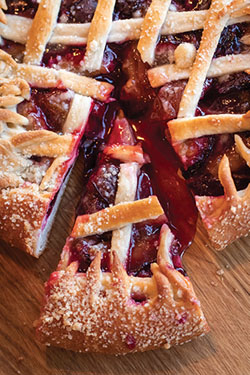
© Valeria Boltneva | Pexels.com
|
Cherry Pie Filling |
||
|
Quantities of ingredients needed for |
||
|
Ingredients |
1 quart jar |
7 quart jars |
|
Fresh or thawed sour cherries |
3 1/3 cups |
6 quarts (24 cups) |
|
Granulated sugar |
1 cup |
7 cups |
|
Clear Jel |
1/4 cup plus |
1 3/4 cups |
|
Cold water |
1 1/3 cups |
9 1/3 cups |
|
Bottled lemon juice |
1 tablespoon plus |
1/2 cup |
|
Cinnamon (optional) |
1/8 teaspoon |
1 teaspoon |
|
Red food coloring (optional) |
6 drops |
1/4 teaspoon |
|
Almond extract (optional) |
1/4 teaspoon |
2 teaspoons |
Quality. Select very ripe, firm, tart cherries. Unsweetened frozen cherries can be used. If sugar has been added, rinse it off while the fruit is still frozen.Thaw frozen cherries before use.
Procedure. Rinse and pit cherries. To keep the stem ends from browning, hold pitted cherries in 1 gallon of water mixed with 1 teaspoon of ascorbic acid crystals or six 500-mg vitamin C tablets. Place 6 cups of fresh cherries at a time in 1 gallon of boiling water and cook for 1 minute after the water returns to a boil; drain well. Keep heated cherries in a covered pot or bowl to retain heat while other batches of cherries are being blanched.
In a large saucepan, combine cold water, sugar, Clear Jel, and cinnamon (optional). If desired, add food coloring and/or almond extract. Stir and cook over medium-high heat until mixture thickens and begins to bubble. Add lemon juice and boil 1 minute, stirring constantly. Fold in drained cherries. Fill hot jars immediately with mixture, leaving a 2-inch headspace. Remove air bubbles and adjust headspace if needed. Process immediately.
|
Peach Pie Filling |
||
|
Quantities of ingredients needed for |
||
|
Ingredients |
1 quart jar |
7 quart jars |
|
Fresh sliced peaches |
3 1/2 cups |
6 quarts (24 cups) |
|
Granulated sugar |
1 cup |
7 cups |
|
Clear Jel |
1/4 cup plus |
2 cups plus |
|
Cold water |
3/4 cup |
5 1/4 cups |
|
Bottled lemon juice |
1/4 cup |
1 3/4 cups |
|
Cinnamon (optional) |
1/8 teaspoon |
1 teaspoon |
|
Almond extract (optional) |
1/8 teaspoon |
1 teaspoon |
Quality. Select ripe but firm peaches. Red Haven, Redskin, Sun High, and other varieties of similar quality are suitable.
Procedure. Peel peaches. To loosen skins, submerge peaches in boiling water for 30 to 60 seconds, then place in cold water for 20 seconds. Slip off skins and cut into slices 1/2 inch wide. Prevent browning by placing slices in 1 gallon of water mixed with 1 teaspoon of ascorbic acid crystals or six 500-mg vitamin C tablets. Place 6 cups of fresh peach slices at a time in 1 gallon of boiling water and cook for 1 minute after the water returns to a boil; drain well. Keep peaches in a covered pot or bowl to retain heat while other batches of peaches are being blanched.
In a large pot, combine sugar, Clear Jel, and a small amount of the cold water to make a thin slurry. Then add the rest of the cold water to the slurry and whisk to prevent clumping. If desired, add cinnamon and/or almond extract. Stir and cook on medium-high heat until mixture thickens and begins to bubble. Add lemon juice and boil 1 minute, stirring constantly. Fold in drained peach slices and continue to heat for 3 minutes. Fill hot jars with mixture, leaving a 1 1/2-inch headspace. Remove air bubbles and adjust headspace if needed. Process immediately.
For Further Reading
E-314: Making Jam, Jelly, and Sweet Spreads at Home
https://pubs.nmsu.edu/_e/E314/
E-321: Freezing Fruit Basics
https://pubs.nmsu.edu/_e/E321/
E-326: Home Canned Sweet Spreads Made with Green Chile
https://pubs.nmsu.edu/_e/E326/
Original author: Priscilla Grijalva, Extension Food and Nutrition Specialist. Subsequently reviewed/revised by Alice Jane Hendley, Extension Food and Nutrition Specialist; Martha Archuleta, Extension Food and Nutrition Specialist; and Carol W. Turner, Extension Food and Nutrition Specialist.

Nancy Flores is the Extension Food Technology Specialist in the Department of Extension Family and Consumer Sciences at NMSU. She earned her B.S. at NMSU, M.S. at the University of Missouri, and Ph.D. at Kansas State. Her Extension activities focus on food safety, food processing, and food technology.

Cindy Schlenker Davies is the County Program Director and Extension Home Economist at NMSU’s Bernalillo County Extension Office. She earned her B.S. at Eastern New Mexico University and her M.A. at NMSU. Her Extension and public outreach work focuses on food processing and preservation and food safety.
This publication was originally adapted for use in New Mexico (1989) from Let’s Preserve: Fruit Pie Fillings, which was developed by Penn State Cooperative Extension Service, U.S. Department of Agriculture.
Brand names appearing in publications are for product identification purposes only. No endorsement is intended, nor is criticism implied of similar products not mentioned. Persons using such products assume responsibility for their use in accordance with current label directions of the manufacturer.
To find more resources for your business, home, or family, visit the College of Agricultural, Consumer and Environmental Sciences on the World Wide Web at pubs.nmsu.edu.
Contents of publications may be freely reproduced, with an appropriate citation, for educational purposes. All other rights reserved. For permission to use publications for other purposes, contact pubs@nmsu.edu or the authors listed on the publication.
New Mexico State University is an equal opportunity/affirmative action employer and educator. NMSU and the U.S. Department of Agriculture cooperating.
Revised November 2019 Las Cruces, NM


